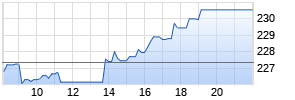
New Schneider Electric Research Details How Higher Chilled Water Temperatures Can Improve Data Centre Cooling and Energy Efficiency by 64%
PR Newswire
LONDON, May 17, 2018
LONDON, May 17, 2018 /PRNewswire/ --
- A study of two data centres found that utilising higher temperatures resulted in energy savings of between 41% and 64%, whilst driving significant improvements in PUE
- A small increase in capital expenditure for additional air cooling systems, redesigned cooling coils and additional adiabatic coolers is offset by reduced energy costs
- Payback in terms of reduced Total Cost of Ownership is achieved over three years
Energy efficiency is an issue that concerns all who are involved with the design and operation of data centres. The cooling function in general, and the operation of water chillers in particular, are large consumers of power and as such, require focused efforts to improve overall energy efficiency.
Water chillers account for between 60 and 85% of overall cooling-system energy consumption. Consequently, data centres are designed, where possible, to keep usage of chillers to a minimum and to maximise the amount of available "free cooling", in which less power-hungry systems such as air coolers and cooling towers can keep the temperature of the IT space at a satisfactory level.
One approach to reducing water chiller energy consumption is to design the cooling system so that a higher outlet water temperature (CHW) from the chillers can be tolerated while maintaining a sufficient cooling effort. In this way, chillers consume less energy by not having to work as hard, and the number of free cooling hours can be increased.
As with any complex system, attention needs to be paid to all parts of the infrastructure, as changes in one area can have direct implications for another. A new White Paper from Schneider Electric, the global specialist in energy management and automation, examines the effect on overall cooling system efficiency by operating at higher chilled water temperatures.
White Paper #227, "How Higher Chilled Water Temperature Can Improve Data Center Cooling System Efficiency", outlines the various strategies and techniques that can be deployed to permit satisfactory cooling at higher temperatures, whilst discussing the trade-offs that must be considered at each stage, comparing the overall effect of such strategies on two data centres operating in vastly different climates.
Among the trade-offs discussed were the need to install more air-handling units inside the IT space to offset the higher water-coolant temperatures, in addition to the need for redesigned equipment such as coils, to provide adequate cooling efforts when CHW (chilled water temperature) exceeds 20C. The paper also advises the addition of adiabatic, or evaporative, cooling to further improve heat rejection efficiency. Each approach requires an additional capital investment, but results in lower long-term operating expenses due to the improved energy efficiency.
ARIVA.DE Börsen-Geflüster
Weiter aufwärts?
| Kurzfristig positionieren in Schneider Electric | ||
|
UM1SL8
| Ask: 1,57 | Hebel: 19,02 |
| mit starkem Hebel |
Zum Produkt
| |
|
UM00J7
| Ask: 4,03 | Hebel: 5,97 |
| mit moderatem Hebel |
Zum Produkt
| |

Kurse
 |
White Paper 227 details two real-world examples in differing climates; the first is in a temperate region (Frankfurt, Germany) and the second in a tropical monsoon climate (Miami, Florida). In each case, data was collected to assess the energy savings that were accrued by deploying higher CHW temperatures at various increments, whilst comparing the effect of deploying additional adiabatic cooling.
The study found that an increased capital expenditure of 13% in both cases resulted in energy savings of between 41% and 64%, with improvements in TCO between 12% and 16% over a three year period.
Another inherent benefit of reducing the amount of energy expended on cooling is the improvement in a data centres PUE (Power Usage Effectiveness) rating. As this is calculated by dividing the total amount of power consumed by a data centre by the power consumed by its IT equipment alone, any reduction in energy expended on cooling will naturally reduce the PUE figure.
The Schneider Electric study found that PUE for the two data centres examined was reduced by 14% in the case of Miami and 16% in the case of Frankfurt.
White Paper #227 "How Higher Chilled Water Temperature Can Improve Data Center Cooling System Efficiency" is immediately available for free download ">by clicking here, or visiting http://www.apc.com/wp?wp=227
About the authors
Paul Lin is a Senior Research Analyst at Schneider Electric's Data Center Science Center. He is responsible for data centre design and operation research and consults with clients on risk assessment and design practices to optimize the availability and efficiency of their data centre environments. He holds a master's degree in mechanical engineering from Jilin University
Victor Avelar is the Director and Senior Research Analyst at Schneider Electric's Data Center Science Center. He is responsible for data centre design and operations research and consults with clients on risk assessment and design practices to optimize the availability and efficiency of their data centre environments. He holds a bachelor's degree in mechanical engineering from Rensselaer Polytechnic Institute and an MBA from Babson College.
John Bean Jr is the Director of Innovation for Racks and Cooling Solutions at Schneider Electric. Previously he was World Wide Engineering Manager for Cooling Solutions at Schneider Electric, developing several new product platforms and establishing engineering and laboratory facilities in both the USA and Denmark. Before joining APC, John was Engineering Manager for other companies involved in the development and manufacture of mission-critical cooling solutions.
About Schneider Electric
Schneider Electric is leading the Digital Transformation of Energy Management and Automation in Homes, Buildings, Data Centers, Infrastructure and Industries.
With global presence in over 100 countries, Schneider is the undisputable leader in Power Management - Medium Voltage, Low Voltage and Secure Power, and in Automation Systems. We provide integrated efficiency solutions, combining energy, automation and software.
In our global Ecosystem, we collaborate with the largest Partner, Integrator and Developer Community on our Open Platform to deliver real-time control and operational efficiency.
We believe that great people and partners make Schneider a great company and that our commitment to Innovation, Diversity and Sustainability ensures that Life Is On everywhere, for everyone and at every moment.
http://www.schneider-electric.com
Related resources:
- White Paper #227, "How Higher Chilled Water Temperature Can Improve Data Center Cooling System Efficiency"
- Schneider Electric White Papers
- Blog: Schneider Electric Data Center Science Center
- Schneider Electric Chilled Water Systems
Hashtags: #datacentre #PUE #Efficiency #Cooling #EcoStruxure
Follow us on:
SOURCE Schneider Electric

Mehr Nachrichten zur Schneider Electric Aktie kostenlos abonnieren
(Mit der Bestellung akzeptierst du die Datenschutzhinweise)

Hinweis: ARIVA.DE veröffentlicht in dieser Rubrik Analysen, Kolumnen und Nachrichten aus verschiedenen Quellen. Die ARIVA.DE AG ist nicht verantwortlich für Inhalte, die erkennbar von Dritten in den „News“-Bereich dieser Webseite eingestellt worden sind, und macht sich diese nicht zu Eigen. Diese Inhalte sind insbesondere durch eine entsprechende „von“-Kennzeichnung unterhalb der Artikelüberschrift und/oder durch den Link „Um den vollständigen Artikel zu lesen, klicken Sie bitte hier.“ erkennbar; verantwortlich für diese Inhalte ist allein der genannte Dritte.



